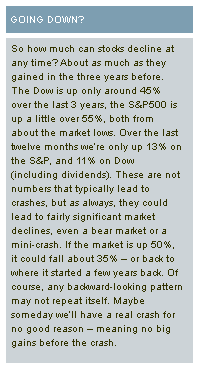Crash?
Every investor fears a stock market crash. The idea of losing 20% or more of your net worth in a matter of hours is the ultimate nightmare. Oddly enough, the mundane (and molasses-in-winter slow) market events tend to hurt investors more over the long haul than sudden drops. Even adjusting for inflation, investors lost far more in 2002 than they did in 1987 - the year of the biggest one-day market decline in history.
So what is a crash, why does it happen?
A bear market is generally accepted to be one that falls more than 20% from its high. In a mere bear market, investors might sell stocks over months or years if they lose interest, if they become risk-averse, if earnings disappoint, if interest rates climb, if a recession looms, or a combination of dozens of variables. Our last bear market was in 2000-2002. There have been dozens of bear markets throughout history.
In a way, a crash is a very sudden bear market caused by panic. Unlike a bear market, a crash happens over a few days - or even hour. Investors try to sell any and all stocks at just about any price. Buyers largely disappear and whole swaths of stocks can drop by several dollars a share with no buyers willing to invest at the lower prices.
Crashes of 20% or more are surprisingly rare. While we’ve had several fast big drops – mini crashes if you will – a real plunge is a once-in-a-generation event (or so we hope). Fears over emerging markets in October 1997 led to a 550 point shellacking of the Dow, or about 7%, in a day. Circuit breakers put in place in 1987 – the last real crash – act like fuses to stop market trading when the market goes down (or up) more than a certain amount in a day.
Crashes happen after stocks go up too fast. Not merely 10 or 20% in a year, but 30% or 40%, and nearly double in the three years or so leading up to the crash. Such a big move generally takes stocks to unsustainable valuations, but high P/E (price to earnings) ratios alone don't always lead to a decline - such rational thinking would have prevented the run-up in the first place.

The market (S&P500) was up about 33% in the 12 months before and just over 100% in the three years before the ’87 crash. The market was up 48% in the year before, and 135% in the three years before the ’29 crash (a 30% two-day drop that ultimately lead to a decline of nearly 90%).
Every major crash in history (not just broad U.S. stocks indexes but Japanese stocks and real estate twenty five years ago, Florida real estate in the early 1920s, Russian stocks in 1998, even tulip bulbs centuries ago), has been preceded by equally high gains leading up to the crash. The NASDAQ was down to around 1,100 from over 5,000 from 2000 to 2002, but was up from 1,200 in 1997 to over 5,000 in the three years before the fall. Easy up, easy down.
We bring all this up not to frighten, but to highlight a few strategies we have in the portfolios that work around up and down markets.
The Powerfund Portfolio strategy is contrarian at heart, and by definition avoids asset classes that post big gains. Generally speaking, when a mutual fund goes up, its Powerfund Rating (our measure of a fund’s future performance potential) goes down. We’ve seen big gains in emerging markets (we are up 200% in one emerging market fund) Japan stocks, microcap and small-cap stocks, among others. These are all areas that could see actual crashes.
We are light (or out entirely) of these areas not simply because they have risen so fast, but because such moves attract investors, which perhaps is ultimately why markets that go up so fast fall even faster.
We don’t know when a crash will happen, or how long it will last, much less a bear market. We intend to increase our exposure on the sort of falls that make investors lose their appetite for investing and decrease our exposure after rises that attract investors. At best, this increases our longer-term returns but does not mean further falls can’t happen.
